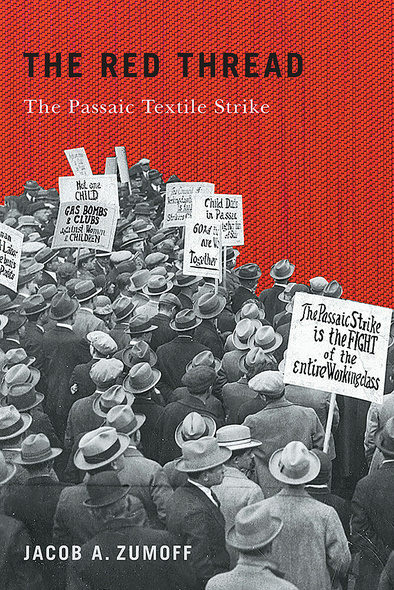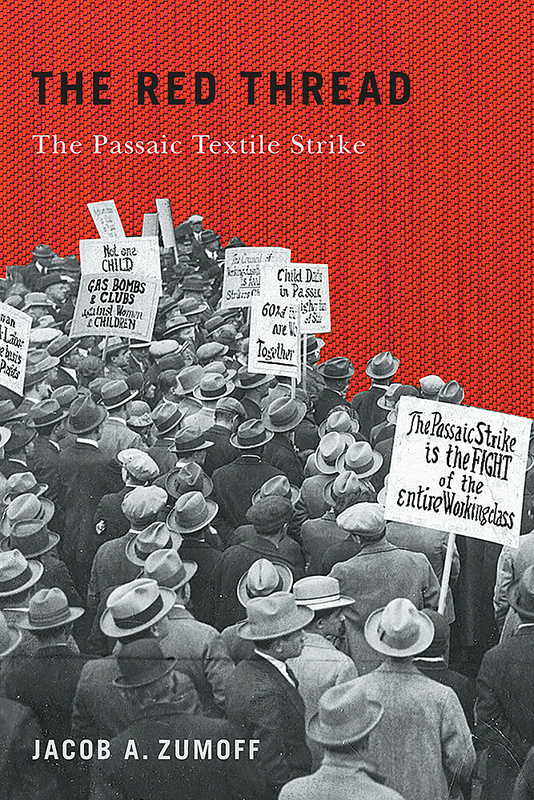
248 pages, 6 x 9
20 b-w illustrations
Paperback
Release Date:16 Jul 2021
ISBN:9781978809895
Hardcover
Release Date:16 Jul 2021
ISBN:9781978809901
This book tells the story of 15,000 wool workers who went on strike for more than a year, defying police violence and hunger. The strikers were mainly immigrants and half were women. The Passaic textile strike, the first time that the Communist Party led a mass workers’ struggle in the United States, captured the nation’s imagination and came to symbolize the struggle of workers throughout the country when the labor movement as a whole was in decline during the conservative, pro-business 1920s. Although the strike was defeated, many of the methods and tactics of the Passaic strike presaged the struggles for industrial unions a decade later in the Great Depression.
Zumoff’s work is an important addition to the history of both the American labor movement and the history of the American Left. Zumoff has combed monographs, manuscripts, and memoirs to develop a rich historical narrative of the 1926 Passaic Strike, its origins, its aftermath, and larger meaning.
I have focused as a labor history scholar for almost twenty-five years, and I feel The Red Thread represents the highest standards of scholarship in the field, and is especially interesting for the new ground it covers on the development of radical politics and class consciousness in the Garden State before the Great Depression--a period which is too often overlooked.
Jacob A. Zumoff pulls the story of one of New Jersey's longest work stoppages from the historical shadows.
Red Thread is a riveting deep-dive into that history. Let us hope our upsurge is coming. We have work to do to prepare.
Red Thread is a sobering study on the reality of police brutality and repression against workers (the history of the nineteenth and early twentieth century tends to show that if you’re wondering why workers in the United States put up with such terrible conditions, violence and terrorism from the ruling class can never be ruled out)....Zumoff argues convincingly that Communist organizing was not the cause of the strike’s defeat; rather, Communist activism allowed the strike to go on for as long as it did. He rightly refrains from spinning the defeat as a victory — in fact, he criticizes the Communists for doing this — nor does Zumoff try too hard to explain the defeat. It’s common for strikes to fail.
Jacob Zumoff on The Red Thread; the Passaic Textile Strike,' by Rosemary Feurer
Building Solidarity: The Passaic Textile Strike (1926 Film),' by Jacob Zumoff
As a Northern New Jerseyan (not a Jerseyite) with an interest in labor history, I knew about the 1913 Paterson Silk Workers Strike, and the involvement therewith of the 'Wobblies,' back when Paterson was 'Silk City.' Now, thanks to author Jacob A. Zumoff, I know about the context, the events, and the consequences of another radical-tinged strike in my home territory, the Passaic Textile Strike of 1926, which shut down the Botany and Forstmann woolen mills, and others, in Passaic and nearby towns for a year.
Offers a fresh perspective and a 'synthetic' history of the 1926 textile workers strike in Passaic, New Jersey....Zumoff’s microstudy of industrial work and organizing is rich and nuanced. His central narrative thread is the leading role of the Communist Party. Zumoff aptly demonstrates how the party dispatched to Passaic talented and driven organizers.... Historians of American labor and movements will take a particular interest in Zumoff’s discussion of the party’s fundraising initiatives and its use of new forms of media.
The Red Thread’s most impressive feature is its rich amount of archival research....A compelling account of Passaic in 1926 and those whose lives were transformed by the strike. Zumoff ’s major contribution to the historiography of this event is his central positioning of cp materials when analyzing the development of the strike which com- pel the reader to consider the cp’s spirited willingness to organize oppressed American workers established unions preferred to ignore.
Zumoff’s well-researched study effectively uses the Passaic strike to highlight the radical possibilities of workers’ 1920s struggles. The book is a timely consideration of a popular strike in a conservative political moment and will be of interest to undergraduates, graduate students and the general public interested in labour, radicalism, and capitalism.
Zumoff’s The Red Thread, well researched and accessibly written, will serve as Passaic’s epitaph for the foreseeable future. But the meaning of the strike itself, as he suggests, is anything but dead. It is very much with us now. Workers today face difficulties in the transformation of capitalist work and in the ideological war waged against them, not unlike that of the 1920s. How they fight, with whom they ally, and the nature of the leadership they embrace will determine outcomes that take us into the future. Rethinking what happened in Passaic, for which this study is essential reading, will be useful in addressing such considerations. The past is never entirely dead, and its lessons, even as they are revealed in defeats like Passaic, can inform and inspire the present, even help chart the course to a better future.
Zumoff’s work is an important addition to the history of both the American labor movement and the history of the American Left. Zumoff has combed monographs, manuscripts, and memoirs to develop a rich historical narrative of the 1926 Passaic Strike, its origins, its aftermath, and larger meaning.
I have focused as a labor history scholar for almost twenty-five years, and I feel The Red Thread represents the highest standards of scholarship in the field, and is especially interesting for the new ground it covers on the development of radical politics and class consciousness in the Garden State before the Great Depression--a period which is too often overlooked.
Jacob A. Zumoff pulls the story of one of New Jersey's longest work stoppages from the historical shadows.
Red Thread is a riveting deep-dive into that history. Let us hope our upsurge is coming. We have work to do to prepare.
Red Thread is a sobering study on the reality of police brutality and repression against workers (the history of the nineteenth and early twentieth century tends to show that if you’re wondering why workers in the United States put up with such terrible conditions, violence and terrorism from the ruling class can never be ruled out)....Zumoff argues convincingly that Communist organizing was not the cause of the strike’s defeat; rather, Communist activism allowed the strike to go on for as long as it did. He rightly refrains from spinning the defeat as a victory — in fact, he criticizes the Communists for doing this — nor does Zumoff try too hard to explain the defeat. It’s common for strikes to fail.
Jacob Zumoff on The Red Thread; the Passaic Textile Strike,' by Rosemary Feurer
Building Solidarity: The Passaic Textile Strike (1926 Film),' by Jacob Zumoff
As a Northern New Jerseyan (not a Jerseyite) with an interest in labor history, I knew about the 1913 Paterson Silk Workers Strike, and the involvement therewith of the 'Wobblies,' back when Paterson was 'Silk City.' Now, thanks to author Jacob A. Zumoff, I know about the context, the events, and the consequences of another radical-tinged strike in my home territory, the Passaic Textile Strike of 1926, which shut down the Botany and Forstmann woolen mills, and others, in Passaic and nearby towns for a year.
Offers a fresh perspective and a 'synthetic' history of the 1926 textile workers strike in Passaic, New Jersey....Zumoff’s microstudy of industrial work and organizing is rich and nuanced. His central narrative thread is the leading role of the Communist Party. Zumoff aptly demonstrates how the party dispatched to Passaic talented and driven organizers.... Historians of American labor and movements will take a particular interest in Zumoff’s discussion of the party’s fundraising initiatives and its use of new forms of media.
The Red Thread’s most impressive feature is its rich amount of archival research....A compelling account of Passaic in 1926 and those whose lives were transformed by the strike. Zumoff ’s major contribution to the historiography of this event is his central positioning of cp materials when analyzing the development of the strike which com- pel the reader to consider the cp’s spirited willingness to organize oppressed American workers established unions preferred to ignore.
Zumoff’s well-researched study effectively uses the Passaic strike to highlight the radical possibilities of workers’ 1920s struggles. The book is a timely consideration of a popular strike in a conservative political moment and will be of interest to undergraduates, graduate students and the general public interested in labour, radicalism, and capitalism.
Zumoff’s The Red Thread, well researched and accessibly written, will serve as Passaic’s epitaph for the foreseeable future. But the meaning of the strike itself, as he suggests, is anything but dead. It is very much with us now. Workers today face difficulties in the transformation of capitalist work and in the ideological war waged against them, not unlike that of the 1920s. How they fight, with whom they ally, and the nature of the leadership they embrace will determine outcomes that take us into the future. Rethinking what happened in Passaic, for which this study is essential reading, will be useful in addressing such considerations. The past is never entirely dead, and its lessons, even as they are revealed in defeats like Passaic, can inform and inspire the present, even help chart the course to a better future.
JACOB A. ZUMOFF is the author of The Communist International and U.S. Communism, 1919-1929. He is an assistant professor of history at New Jersey City University.
Illustrations
Abbreviations Used in Text
Introduction: The Passaic Textile Strike of 1926
1 Passaic, New Jersey
2 The Strike Begins
3 The Communist Party and the Start of the Passaic Strike
4 Bringing Passaic to the Labor Movement
5 Enter the Politicians
6 Repression and Class-Struggle Defense
7 Building Relief and Solidarity
8 Women, the Family, and the Passaic Strike
9 The End of the Strike
10 After the Strike
Acknowledgments
Abbreviations Used in Notes
Notes
Selected Bibliography
Index




